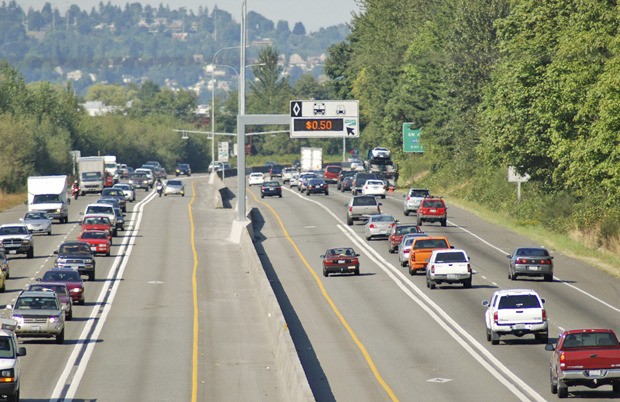Traffic and revenue are meeting or exceeding expectations on the State Route 520 floating bridge while the popularity of the State Route 167 High Occupancy Toll Lanes continues to rise, according to year-end financial statements.
Washington State Department of Transportation (WSDOT) officials will provide updates to the Washington State Transportation Commission on all toll facilities in the state at the commission’s meeting in Olympia on Wednesday.
“This data shows that tolling can provide a big lift to keep traffic moving while generating revenue for future improvements,” said Craig Stone, WSDOT Toll Division director. “Drivers are also learning that tolling can help provide a more reliable trip.”
Average daily traffic across the SR 520 floating bridge in 2012 has been 18 percent higher than expected. Weekend traffic across the bridge has steadily increased as well, with usage rates 36 percent more than anticipated. Even with the higher traffic volumes, drivers are saving about six minutes from their pre-toll travel times.
“Most importantly, we’re ahead of the financial plan,” Stone said. “That keeps us on track to make debt payments to replace the vulnerable floating bridge.”
WSDOT also reports traffic along SR 167 HOT lanes is flowing more efficiently, with volumes tripling since May 2008 while maintaining 60-mph traffic speeds. Since the HOT lanes opened in 2008, peak-hour traffic speeds in SR 167’s general-purpose lanes increased by 20 percent to more than 50 mph on average. During weekday, peak-hour travel, HOT lane drivers saved about six minutes of travel time by paying an average toll of $1.75.
“Not everyone uses them every day, but the HOT lanes are there when people need them,” Stone said. “Drivers also keep telling us they want to see more HOT lanes.”
About tolling on the SR 167 HOT lanes
WSDOT opened the HOT lanes as a pilot project in 2008 to reduce congestion and travel time between Auburn and Renton. HOT lanes offer solo drivers the option for a faster trip by paying a toll, at a rate determined automatically by current traffic levels. Carpools of two people or more always use HOT lanes toll-free.
In March 2011, the state Legislature extended the pilot project through June 30, 2013. With the success of HOT lanes, WSDOT plans to request that the Legislature make the SR 167 HOT Lanes permanent. Long-range plans include connecting the SR 167 HOT Lanes to planned Interstate 405 Express Toll Lanes for a 40-mile express trip to Interstate 5.
About tolling on the SR 520 floating bridge
Tolling on SR 520 is expected to raise $1 billion overall toward the $4.65 billion SR 520 bridge replacement and HOV program, which builds 12.8 miles of safety and mobility improvements from Interstate 5 in Seattle to State Route 202 in Redmond.
The existing SR 520 floating bridge opened to traffic in 1963, and is vulnerable to sinking during a severe storm after weathering decades of wind and waves. The new bridge will better withstand storms and move more people across the lake with a new transit/HOV lane for buses and carpools in each direction. The target date to open the new bridge to traffic is December 2014.
=====
LINKS:


